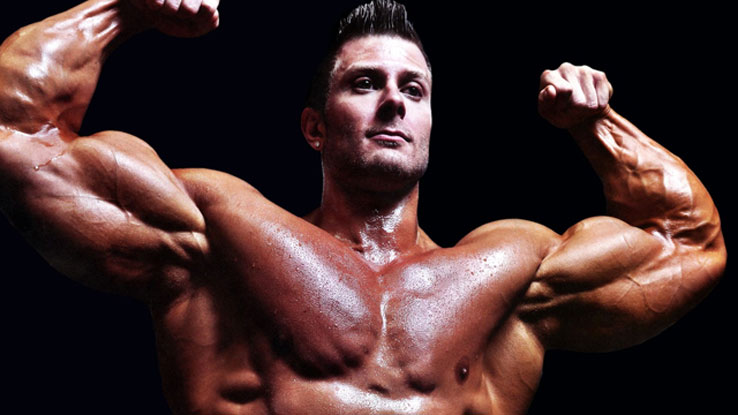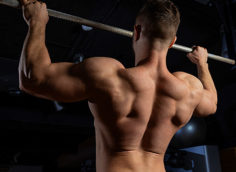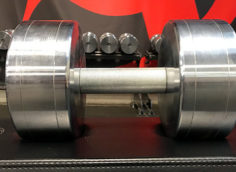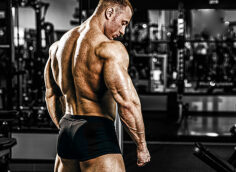Gene Lawrence is a 73 year-old powerlifter who stays up-to-date with the writings and recommendations of his favorite strength coaches. Like many lifters, he finds the conflicting advice extolled by the various experts to be downright confusing.
I've been training with Gene for the past several months, watching him bust out 365-pound deadlifts like it ain't no thang. Just recently he said to me, "I really wish someone would just write an article that taught me the rules. What are the things you have to do versus the things that are just nice to do?"
I pondered his question for several days, and came to the conclusion that there are only 8 laws in strength training.
At first I figured there'd be more, but almost every time I thought up a potential law, a refuting argument came to mind.
Now of course, it's difficult to make hard-fast laws due to varying goals and genetics. However, in the end I feel that I was fair with my determinations.
These laws are based on what I've learned both as a lifter and researcher, and they're formed by my current level of scientific understanding, meaning they're malleable and subject to change.
Bear in mind here that I'm assuming that since you read T Nation, you care about both your strength and your physique.
In Part II of this series, I'll give you the 8 laws, but in this article I'll set the stage and present 20 potential laws that got shot down. Many coaches and trainers might determine that some of these are indeed laws, but not me.
The following 20 things are "nice" to do, but not absolutely necessary.
The 20 "Almost" Laws that Didn't Make the Cut
Foam rolling feels good. Ask any foam rolling lifter if it makes them feel better, alleviates pain, or prevents injury, and the resounding answer will be yes.
However, there are millions of lifters who don't foam roll who do just fine. To date, there are only a couple of studies that have been conducted on foam rolling, and to be frank, we really don't know much about it as far as what it does and doesn't do (Miller & Rockey 2006, MacDonald et al. 2012).
Right now we can speculate as to what it does, but at this point it's just that – speculation.
Stretching usually feels good too, and intuitively most lifters feel like it's a good idea. Nobody wants to lose their flexibility, and it's no fun being tight.
However, proper strength training itself involves stretching. Research shows that strength training is as effective as stretching at building flexibility, due to several factors (Aquino et al. 2010, Simao et al. 2010; Morton et al. 2011, Nelson & Bandy 2004).
First, the eccentric component of exercise, along with exercises that place sufficient tension on muscles at long lengths, induces sarcomerogenesis and actually increases flexibility through creating new sarcomeres in series and lengthening muscle (Brughelli & Cronin 2007). So resistance training is a viable form of loaded, active stretching.
Next, passive stretching can indeed decrease stiffness and increase pain tolerance to stretch, but it doesn't regulate muscle length like active stretching does (Weppler & Magnusson 2010, Riley & Van Dyke 2012). If you regularly perform exercises like full squats, Romanian deadlifts (RDL's), lunges, chin-ups, dips, and calf raises with good form through a full range of motion, you'll possess good overall flexibility.
Cardio sounds good in theory. After all, the heart is the most important muscle, right? But what exactly is "cardio?" Doesn't the heart beat quite hard during strength training?
While prolonged low-intensity cardiovascular exercise does indeed have its own merits, strength training – particularly performed intensively close to muscular failure – provides many of the benefits that cardio does (Steele et al. 2012).
As long as you have an active lifestyle and lift weights frequently with sufficient intensity, cardio isn't mandatory. If you've ever performed a set of 20-rep walking barbell lunges with 225 pounds, then you know that resistance training works the cardiovascular system very well.
Over the past decade, exercise scientists have raved about HIIT, pointing out that it leads to greater metabolic expenditure and fat-loss over prolonged periods compared to steady state cardio due to the effects of EPOC (Tremblay 1994, Hazell et al. 2012). However, lifting weights is a form of HIIT, as long as you train intensely.
Recently, it's been shown that lighter weights performed to failure can indeed provide a potent muscle hypertrophy stimulus, perhaps even greater than heavy weights (Mitchell et al. 2012).
It's too early to tell as the studies have relied on beginner subjects, but at the very least the newer research shows that you can certainly build muscle without using heavy weights.
Ever seen Kai Greene train his glutes? He uses light weight for high reps and focuses on feeling the glutes moving the loads. Jay Cutler doesn't go nearly as heavy as he did earlier in his career, but nevertheless he's more muscular due to a shift in focus on muscle contraction.
Few bodybuilders go lower than 6 reps, and for lower body most stick to sets of 10-30 reps. For the most part, Andy Bolton, the first man to deadlift over 1,000 pounds, relies upon Dynamic Effort deadlifts to build his world class deadlifting strength.
Many lifters benefit from the Dynamic Effort method. Explosive lifting increases muscle activation at the start of the lift and allows for more frequent training due to lighter loads being used.
However, explosive lifting also diminishes muscle activation in the latter half of the lift due to requisite deceleration of the load (Frost et al. 2010).
Most bodybuilders lift semi-explosively, yet they're sure to control the weight through the entire ROM. Many seek to keep more constant tension on the muscles to maximize the pump effect.
Furthermore, many powerlifters have gained plenty of strength having never focused on lighter weight for maximum acceleration. Dynamic Effort work is a great idea for Olympic lifters and athletes, but it's not mandatory for general lifters.
Growing up reading strength training articles, I was led to believe that the last rep of a set was the only one that counted and the only one that built strength. Now I realize that it was hogwash.
You can build incredible strength staying far away from failure. Sure you won't build maximum strength if you don't push the boundaries from time to time, but you can leave a rep or two in the tank and still be quite strong and muscular.
In fact, a recent article showed that maximum muscle activation during a set was reached a few reps prior to failure (Sundstrup et al. 2012). A decent case could be made that by avoiding the increased wear-and-tear on the joints and nervous system induced by going too heavy or too hard might lead to increased progress through decreased stress, pain, and injury, along with increased recovery.
The squat is the king of lower body movements, no doubt. But do you have to squat? Some lifters never seem to dial down their form on squats, and this has much to do with their anthropometry.
Ben Bruno has shown that it's indeed possible to make steady progress with squatting strength through intensive focus on single-leg strength. Research has shown that single-leg strength and power training led to slightly better performance effects than double-leg strength and power training, though the effects weren't significant (McCurdy et al. 2005).
Strength is highly dependent on the movement pattern, so as long as you perform a single-leg squatting movement such as a Bulgarian split squat or a reverse lunge, your strength on the squat won't suffer dramatically.
Let's say that week in and week out you performed a bilateral deadlift or good morning variation along with a single-leg squat variation, yet you never did bilateral squats. Your quads would still be muscular, your spine stable, and your hips strong.
If the squat is the king of lower body movements, the deadlift is the king of total body movements. Therefore you must deadlift to see great results, right?
Westsiders showed long ago that a lifter could build a very strong deadlift without deadlifting. They performed tons of box squats, good mornings, back raises, pull-throughs, reverse hypers, and glute ham raises – and their deadlifts were incredibly strong.
I've found that heavy-ass kettlebell swings can do wonders for building and maintaining deadlift strength. Max Shank can single-leg RDL 315 pounds for reps, which provides a huge training effect for the hip extensors, keeping the deadlift pattern strong while sparing the low back.
In terms of bodybuilding, many lifters prefer the blend of bent-over rows, T-bar rows, and back extensions for their mid and lower back development rather than deadlifts, as they've found that the deadlift just isn't worth the risk to their body.
If your program contained heavy KB swings, box squats, good mornings, bent over rows, T-bar rows, and back raises, your deadlift would be plenty strong, and your back and hip extensors would display impressive muscularity.
Now let's move on to the king of upper body movements, the bench press. The bench press is without a doubt the most popular exercise in the world, but do you have to perform it? Many lifters' shoulders just don't agree with the bench press, and therefore, they need not include it in their programs.
You can build a strong bench press through other pressing movements. For example, a lifter who performed lots of weighted push-ups and/or dumbbell pressing from different angles will have muscular pecs and triceps, not to mention a reasonably strong bench press.
Let's say a lifter only performed squats, leg presses, deadlifts, hip thrusts, back extensions, glute ham raises, bench press, military presses, dips, push-ups, bent-over rows, chins, and barbell curls for his entire lifting career. I think we'd all agree that he'd be incredibly strong and muscular, provided of course that he gets strong on those exercises.
Conversely, let's say a lifter only performed Bulgarian split squats, reverse lunges, single-leg RDL's, sled-pushes, single-leg hip thrusts, single-leg back extensions, single-arm db bench presses, single-arm DB shoulder presses, one-arm DB rows, single-arm pulldowns, and alternating DB curls for his entire lifting career. He'll also be incredibly strong and muscular, provided he gets strong on those exercises.
Free-weight compound exercise does a good job of activating the core musculature. Getting an aesthetically pleasing mid-section has more to do with being lean than possessing muscular abdominals anyway.
If you perform exercises such as chin-ups, push-ups, squats, deadlifts, farmer's walks, military presses, and barbell curls, your core will be plenty strong and muscular. Combine this with proper nutrition and your midsection will look great.
Free weights reign supreme in the strength training world. They allow for natural movement patterns and require real-world stabilization. Therefore they're absolutely necessary, right? Not so fast.
Prime-mover muscle activation can be matched with machine training, and a lifter can gain incredible strength and size this way.
Moreover, there's a big difference between a crummy machine program and an optimal machine program.
For example, if a lifter simply performed leg extensions, leg curls, calf raises, pec deck, straight-arm pulldowns, and lateral raises, he probably wouldn't get very far in terms of total body strength and muscularity.
However, if a lifter performed Lever squats, Hammer strength deadlifts, leg presses, lying leg curls, Hammer strength upper body presses and pulls from various angles, and cable curls, he'll be incredibly strong and muscular, provided he gets strong on those exercises.
Earlier in a lifter's career, progressive overload is mandatory. But later on, there are other ways of progressing. For example, you can use better form, emphasize a particular muscle, or exert better control.
Many bodybuilders, in an attempt to spare their joints and decrease the likelihood of injury, actually place heavy squats and/or deadlifts toward the end of the workout so they can achieve a training effect while not relying on such heavy loads.
Let's say you've built your strength up to a 300-pound bench, 400-pound squat, and 500-pound deadlift, and you decide to stay there for a year while improving upon your form and honing in on your diet. You'd look better despite not using progressive overload. Progressive overload is critical, but it's not always mandatory.
Variety is the spice of life. Training can be quite mundane, and it's always nice to spruce your programs up with new exercises, altered stance and grip widths and ranges of motion, or other tweaks such as pause reps or drop sets. Failure to vary your workouts is said to lead to stagnation and "habituation".
However, is variety truly necessary? Plenty of Olympic weightlifters from Bulgaria didn't fall into this trap – they performed around six exercises year-round. And this is the crux of John Broz's system – back squats, front squats, power cleans, power snatches, clean & jerks, and snatches.
Let's say that a certain lifter performed the same five exercises his entire lifting career, and for 30 straight years he only did back squats, deadlifts, bench press, military press, and bent over rows. He'd probably have better strength and development than 90% of lifters.
Variety is nice – we all like it, it breaks up the monotony, and it keeps us interested in going to the gym, but if you don't like change, then you don't have to change in order to see excellent results.
Periodization is essential for lifting success, right? The Russians were all about it, and American sports scientists have gone to great lengths planning detailed cycles of varying lengths. So it has to be mandatory for success, right?
The fact is, periodization is debated in the literature, and studies don't tend to show a huge difference in gains between varying periodization models (Kiely 2012, Issurin 2010).
If you're in tune with your body, you possess ample "common sense", and you know the basics of program design, then you don't really need to "periodize" your training.
But first let me clarify this statement. What is "periodization" anyway? It's "planning". How can any sensible lifter not perform some sort of planning when he trains? Even the biggest fools at the gym know what their "go-to" exercises are for the chest and biceps.
The vast majority of respectable lifters plan their training splits, training frequency, exercise selection, and order. Based on intuition and biofeedback, they tend to vary the intensity and volume on a particular day, but there's some structure and planning to their methods.
Therefore, every single respectable lifter does in fact periodize his training. But do you need to jot down an annual plan full of cycles and phases? The vast majority of bodybuilders don't do this, especially the top dogs.
Furthermore, "life" tends to force you into cycles and phases. Stress, new jobs, vacations, injuries, parties, holidays, work, deadlines, new relationships, and travel force lifters into varying their programming.
Moreover, periodization doesn't allow for "on-the-fly" adjustments and can be too rigid. Chuck Vogelpohl was notorious for maxing out on his Dynamic Effort day; once he got ramped up he couldn't resist going heavy. Are you going to tell him he's not lifting correctly?
As mentioned above, life forces you into fluctuating your training stress. Nevertheless, should you plan recovery weeks? Probably, but what if you're the type of lifter who simply "nails" the optimal training variables each week?
Some lifters lack testicular-fortitude and never overreach. These folks don't need back-off weeks. Some lifters train balls-to-the-wall and are prone to overdoing it. These folks benefit greatly from deloading.
But there are certain lifters who intuitively understand just how hard to push things. They might slightly overreach by Friday, but after taking the weekend off, they're good to go by Monday. They make steady gains despite never taking a week off or even taking a back-off week, due to the fact that they perform just the right amount of frequency, volume, and intensity for their body week in and week out.
I'm a huge fan of HFT. But is it absolutely necessary? Some of the best gains I ever made were from a HIT program. Every five days, I performed a full-body workout consisting of big basic movements such as squats or front squats, deadlifts or sumo deadlifts, bench presses or close grip bench presses, and chins or rows. I got incredibly strong and gained a lot of muscle. Mike Mentzer saw great success from infrequent, full-body, intense training, as have plenty of other strong lifters.
One of the biggest misconceptions out there is that you have to be in the gym all day long in order to see results. If more aspiring lifters knew that they could in fact see incredible gains from lifting just six days per month, they'd probably embark on a resistance training regimen.
The caveat is that you have to do it right – no wimpy isolation lifts allowed. Hammer the big basic movements every five days and you'll see great results.
The vast majority of bodybuilders split their programs. Many powerlifters split things up too. Total body training works for many individuals, but no single system is ideal for every individual and goal.
On the contrary, Olympic lifters don't split their workouts, nor do most strongmen or athletes. There are prisoners who've gotten incredibly jacked from daily full-body workouts. Split training works for many individuals, but no single system is ideal for every individual and goal.
Research clearly shows that multiple sets trump single sets for strength and size (Krieger 2009, Krieger 2010, Rhea et al. 2002). However, think of it this way:
Let's say that a lifter did one exercise per workout and squatted on Monday, benched on Wednesday, and deadlifted on Friday. He performs five sets in each session.
Let's say another lifter did one set of five compound exercises on Monday, Wednesday, and Friday. They're both doing 15 sets of exercise per week. Do you really think that they'd be much different in terms of strength or size?
Aside from a couple of warm-up sets, Dorian Yates performed one set to failure, and he had one of the best physiques in the history of bodybuilding.
The first set is by far the most important, with each subsequent set being less and less important. And if you end up hitting the muscles from more angles due to more exercises being performed, a case could be made that you can see even better results in terms of hypertrophy with single-set protocols versus multiple-set protocols.
If you don't go all-out every session, you won't progress, right? Maybe not. Many experts feel that overdoing things holds more lifters back than underdoing things. Leaving a rep or two in the tank, choosing less-taxing exercise variations, and performing Dynamic Effort work allows lifters to train more frequently by sparing the nervous system and the joints from heavy pounding.
Pavel Tsatsouline advises lifters to "grease the groove" and quit obsessing about maximal performance on every set of every exercise.
Let's say you train five days per week, never quite going to failure or maxing out on chain close grip bench press, feet-elevated inverted rows, chain front squats, heavy kettlebell swings, and farmer's walks. You'd be very fit, strong, and muscular, and your joints would thank you.
I'm definitely not telling you that you shouldn't do the things mentioned in this article. However, some of the tenets listed will be more or less important for you depending on your particular genetics and goals. Just keep in mind that these 20 items are nice to do, but not absolutely mandatory for success.
In Part 2 of this series I will disclose the things you must do to ensure optimal gains in strength training.





